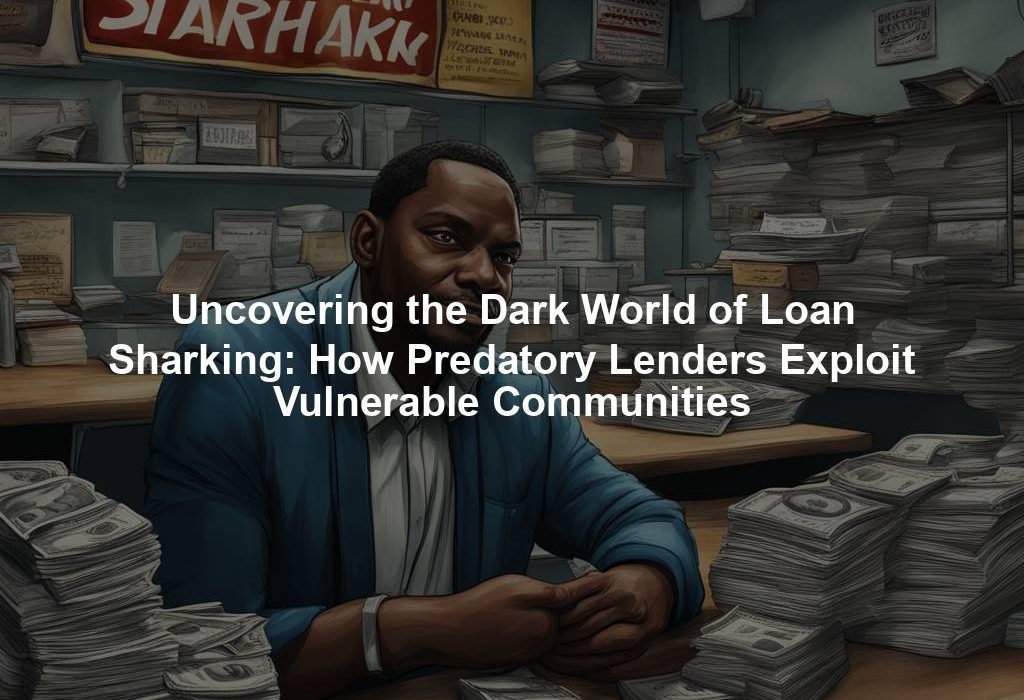Ripping Apart the Fabric of Trust: Investigating the Trauma Caused by Predatory Lenders
In communities across the globe, a detrimental industry lurks in the shadows, preying on the most vulnerable segments of society – loan sharking. These unscrupulous lenders offer immediate financial relief to those in dire need, but at an immense cost. With astronomical interest rates, obscured fees, and coercive collection methods, these lenders ensnare borrowers in a web of debt from which escape seems almost unattainable.
Understanding the Depths of Loan Sharking
Loan sharking, a term synonymous with predatory lending, involves providing loans to individuals at exorbitantly high interest rates, often coupled with undisclosed charges and conditions intended to ensnare borrowers in perpetual indebtedness. These lenders target individuals facing urgent monetary requirements, such as medical emergencies, unforeseen expenditures, or sudden unemployment.
Predatory lenders frequently operate beyond conventional banking systems, rendering it arduous for borrowers to seek assistance or safeguarding from regulatory bodies. They typically dispense loans without necessitating credit evaluations or collateral, facilitating easy qualification for borrowers. However, the loan conditions are often predatory, featuring interest rates surpassing 100% annual percentage rate (APR) and repayment terms structured to perpetuate borrower indebtedness.
Exploitation of Vulnerable Communities by Predatory Lenders
Predatory lenders predominantly focus on communities already grappling with financial adversity, including low-income areas, marginalized populations, and immigrant communities. Exploiting the financial vulnerability of individuals in these regions, these lenders offer immediate funds with scant consideration for repayment capabilities.
In numerous instances, borrowers remain unaware of the loan terms they agree to, as predatory lenders employ deceptive tactics to obfuscate the actual loan cost. For instance, they might propose minimal monthly payments that solely cover the loan interest, leaving the principal sum untouched. This ensnares borrowers in a debt cycle, where they are perpetually repaying interest without diminishing the owed amount.
Moreover, predatory lenders resort to aggressive debt collection methods to intimidate borrowers into settling their debts. Tactics like legal threats, harassment, or even violence are employed to compel individuals to make payments, leaving borrowers disempowered and overwhelmed, exacerbating their financial distress.
The Haunting Impact of Loan Sharking on Communities
The repercussions of loan sharking on communities are profound. Individuals entrapped in perpetual debt struggle to afford essential necessities like food, shelter, and healthcare, leading to heightened stress, mental health complications, and potential homelessness.
Communities at large suffer when predatory lending practices prevail. Research indicates that neighborhoods abundant with payday lenders experience elevated crime rates, diminished property values, and restricted economic prospects, fostering a cycle of poverty that is challenging to break.
Furthermore, the economic instability stemming from loan sharking reverberates throughout the economy. Burdened by substantial debt, individuals are less inclined to spend on goods and services, consequently impeding economic growth and hindering job opportunities.
Combatting the Menace of Loan Sharking
Recent years have witnessed an escalating awareness of the deleterious impacts of loan sharking on vulnerable communities, prompting intensified efforts to combat this exploitative practice. Many states have enforced regulations to cap lender interest rates, mandate transparency in lending operations, and furnish support for individuals victimized by predatory lending.
Community organizations and advocacy groups play a pivotal role in raising awareness of the perils of loan sharking and offering assistance to affected individuals. These entities deliver financial literacy education, legal aid, and advocate for policies safeguarding consumers from predatory lending practices.
Furthermore, alternative lending avenues such as credit unions, community development financial institutions (CDFIs), and microfinance organizations provide accessible and equitable financial products to individuals in vulnerable communities. Emphasizing responsible lending alternatives, these organizations foster financial inclusivity and economic empowerment.
Looking Towards a Brighter Future
Although the battle against loan sharking is far from over, there exists optimism that sustained awareness, advocacy, and regulation can shield vulnerable communities from the exploitative maneuvers of unprincipled lenders. By endorsing fair and transparent lending practices, dispensing education and resources to individuals in need, and promoting alternative financial services, a more just and equitable financial system accessible to all can be established.
Vigilance is crucial for individuals to recognize the indicators of predatory lending and seek assistance if ensnared in exploitative situations. Through collective community efforts, combating loan sharking and constructing a sustainable and just financial framework beneficial to all becomes an achievable reality.




